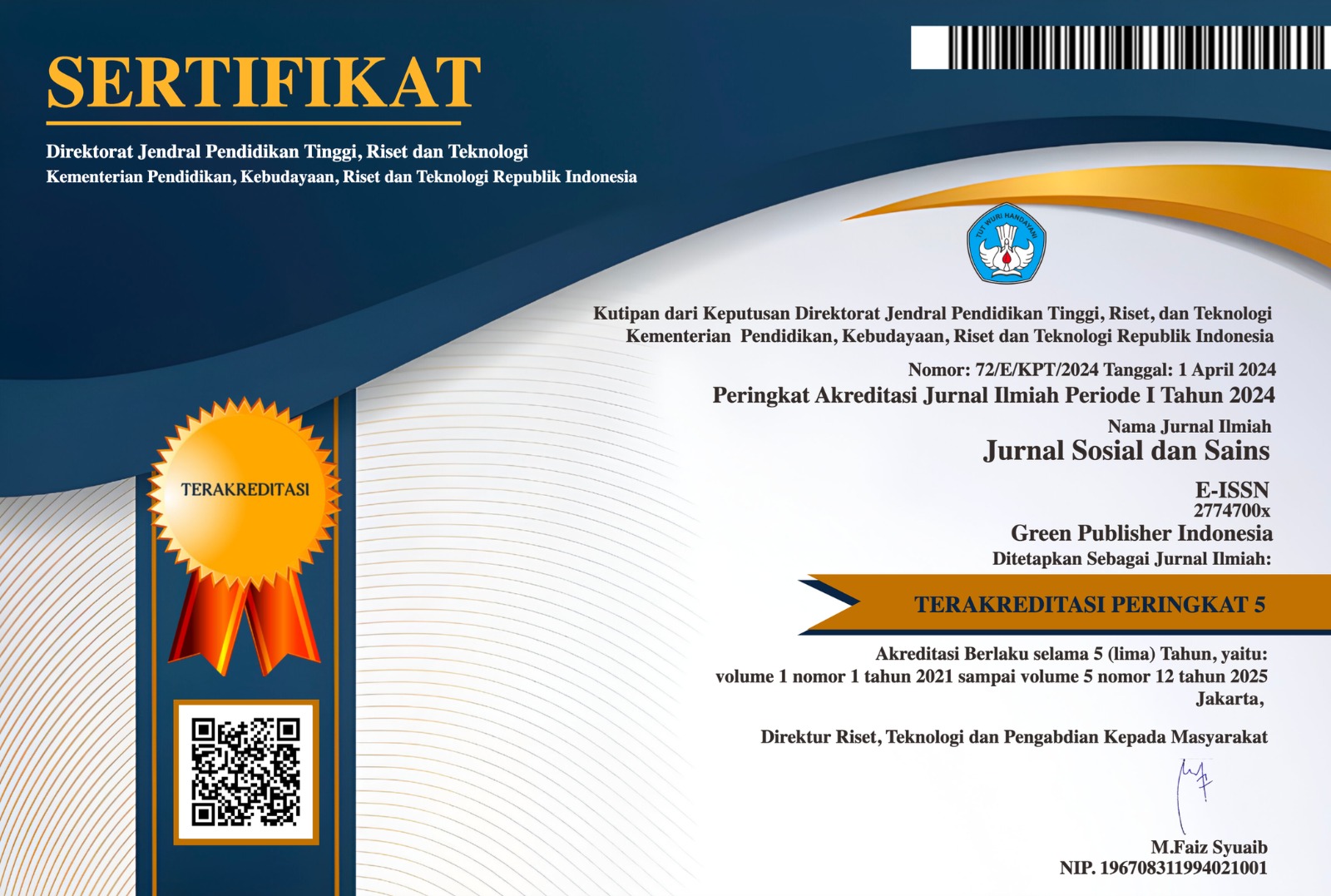Pengaruh Job Demands dan Job Resources terhadap Turnover Intention yang Dimediasi oleh Work Engagement pada PT. Misi Sehat Imani
DOI:
https://doi.org/10.59188/jurnalsosains.v5i4.32103Keywords:
Job Demands, Job Resources, Work Engagement, dan Turnover IntentionAbstract
Penelitian ini bertujuan untuk menganalisis pengaruh job demands dan job resources terhadap turnover intention dengan work engagement sebagai variabel mediasi di PT Misi Sehat Imani (Industri Retail). Meskipun industri retail memiliki potensi besar, tingginya turnover di PT Misi Sehat Imani menjadi hambatan utama yang disebabkan oleh budaya kerja dalam industri retail yang bertanggung jawab atas hal tersebut. Sampel penelitian dikumpulkan menggunakan teknik non-probability sampling dengan jumlah 250 responden karyawan PT Misi Sehat Imani. Analisis data dilakukan menggunakan PLS 4.0 dengan metode partial least square (PLS) dan structural equation model (SEM) untuk menguji hipotesis penelitian. Hasil penelitian menunjukkan bahwa semakin tinggi job demands, work engagement cenderung menurun dan turnover intention meningkat secara signifikan. Job demands di PT Misi Sehat Imani cenderung bersifat hindrance demand, yang ditunjukkan dengan melemahnya work engagement. Sebaliknya, semakin tinggi job resources, work engagement meningkat dan turnover intention menurun secara signifikan. Work engagement berperan memediasi parsial dalam hubungan antara job demands dan job resources terhadap turnover intention, karena job demands dan job resources memiliki pengaruh langsung terhadap turnover intention. Hasil penelitian menekankan pentingnya pengelolaan job demands dan job resources untuk meningkatkan retensi karyawan melalui peningkatan work engagement.
References
Ait Alla, A., & RAJÂA, O. (2019). A Review of the Literature on Employee Turnover. American International Journal of Social Science, 8(3). https://doi.org/10.30845/aijss.v8n3p4
Al-Suraihi, W. A., Samikon, S. A., Al-Suraihi, A.-H. A., & Ibrahim, I. (2021a). Employee Turnover: Causes, Importance and Retention Strategies. European Journal of Business and Management Research, 6(3). https://doi.org/10.24018/ejbmr.2021.6.3.893
Al-Suraihi, W. A., Samikon, S. A., Al-Suraihi, A.-H. A., & Ibrahim, I. (2021b). Employee Turnover: Causes, Importance and Retention Strategies. European Journal of Business and Management Research, 6(3), 1–10. https://doi.org/10.24018/ejbmr.2021.6.3.893
Berisha, G., & Lajçi, R. (2021). Fit to last? Investigating how person-job fit and person-organization fit affect turnover intention in the retail context. Organizations and Markets in Emerging Economies, 11(22), 407–428. https://doi.org/10.15388/OMEE.2020.11.40
Chin, W. W. (2010). The partial least squares approach to structural equation modeling. Modern methods for business research. Modern Methods for Business Research, April, 295-336.
Fuller, D., Logan, B., Suarez, P., & Valkova, A. (2022). How retailers can attract and retain frontline talent amid the Great Attrition. August.
Hair, J. F., Hult, G. T. M., Ringle, C. M., Sarstedt, M., Danks, N. P., & Ray, S. (2021a). An Introduction to Structural Equation Modeling. https://doi.org/10.1007/978-3-030-80519-7_1
Hair, J. F., Hult, G. T. M., Ringle, C. M., Sarstedt, M., Danks, N. P., & Ray, S. (2021b). An Introduction to Structural Equation Modeling. https://doi.org/10.1007/978-3-030-80519-7_1
Hair, J. F., Risher, J. J., Sarstedt, M., & Ringle, C. M. (2019). When to use and how to report the results of PLS-SEM. European Business Review, 31(1), 2–24. https://doi.org/10.1108/EBR-11-2018-0203
Kementrian Koordinator Bidang Perekonomian Republik Indonesia. (2024). No Title. HM.4.6/270/SET.M.EKON.3/04/2024.
Lachowicz, M. J., Preacher, K. J., & Kelley, K. (2018). A novel measure of effect size for mediation analysis. Psychological Methods, 23(2), 244–261. https://doi.org/10.1037/met0000165
Laksono, B. F. W., & Wardoyo, P. (2019). Pengaruh Work – Life Balance, Kepuasan Kerja Dan Work Engagement Terhadap Turnover Intentions Dengan Mentoring Sebagai Variabel Moderating Pada Karyawan Hotel Dafam Semarang. Jurnal Riset Ekonomi Dan Bisnis, 12(1), 17. https://doi.org/10.26623/jreb.v12i1.1525
Lazzari, M., Alvarez, J. M., & Ruggieri, S. (2022). Predicting and explaining employee turnover intention. International Journal of Data Science and Analytics, 14(3). https://doi.org/10.1007/s41060-022-00329-w
Manjula. (2023). Effectiveness Of Employee Retention Strategies. Industrial Engineering Journal, 4(1), 88–100. https://doi.org/10.37421/2161-5833.2023.13.481
Ogbeibu, S., Jabbour, C. J. C., Gaskin, J., Senadjki, A., & Hughes, M. (2021). Leveraging STARA competencies and green creativity to boost green organisational innovative evidence: A praxis for sustainable development. Business Strategy and the Environment, 30(5), 2421–2440. https://doi.org/10.1002/bse.2754
Ongory, H. (2007). A review of the literature on employee turnover. African Journal of Business Management, 5(6), 49–54. https://doi.org/10.1177/036354657700500601
Pandey, P., Singh, S., & Pathak, P. (2019). Factors affecting turnover intentions in the Indian retail industry. International Journal of Human Resources Development and Management, 19(2), 166. https://doi.org/10.1504/ijhrdm.2019.10018450
Sai, V. S., & Pinapati, A. K. (2023). Insights On Employee Turnover: A Bibliometric Analysis. Journal of Law and Sustainable Development, 11(2). https://doi.org/10.55908/sdgs.v11i2.633
Sarstedt, M., Ringle, C. M., & Hair, J. F. (2021a). Partial Least Squares Structural Equation Modeling. Handbook of Market Research, November, 587–632. https://doi.org/10.1007/978-3-319-57413-4_15
Sarstedt, M., Ringle, C. M., & Hair, J. F. (2021b). Partial Least Squares Structural Equation Modeling. Handbook of Market Research, November, 587–632. https://doi.org/10.1007/978-3-319-57413-4_15
Downloads
Published
How to Cite
Issue
Section
License
Copyright (c) 2025 Yuliana Tallo Adu, Elfrida Napitupulu

This work is licensed under a Creative Commons Attribution-ShareAlike 4.0 International License.
Authors who publish with this journal agree to the following terms:
- Authors retain copyright and grant the journal right of first publication with the work simultaneously licensed under a Creative Commons Attribution-ShareAlike 4.0 International (CC-BY-SA). that allows others to share the work with an acknowledgement of the work's authorship and initial publication in this journal.
- Authors are able to enter into separate, additional contractual arrangements for the non-exclusive distribution of the journal's published version of the work (e.g., post it to an institutional repository or publish it in a book), with an acknowledgement of its initial publication in this journal.
- Authors are permitted and encouraged to post their work online (e.g., in institutional repositories or on their website) prior to and during the submission process, as it can lead to productive exchanges, as well as earlier and greater citation of published work.







